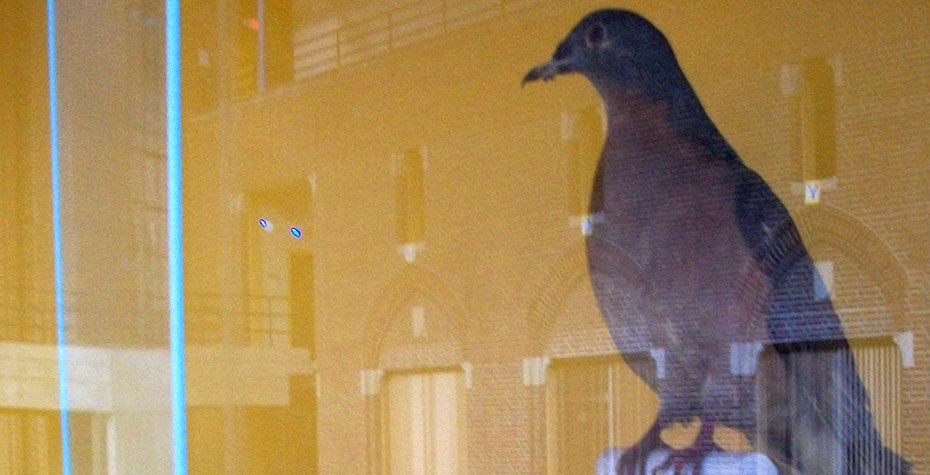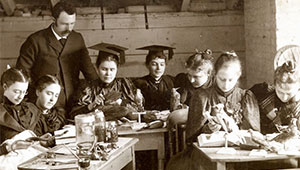Wellesley Specimen and Historic Dates Prompt a Look at Fields of Study Surrounding Extinction

Here we consider two seemingly unlike things: species extinction, and the long history of innovative science education at Wellesley.
These two are linked in the emblem of the passenger pigeon, a species whose last living representative died 100 years ago this week; a species also represented among Wellesley's science teaching artifacts as a taxidermized bird.
The first of September 2014 marks the 100th anniversary of the extinction of a once massively plentiful bird. The third of September 2014 is the 50th anniversary of the federal Wilderness Act of 1964. This week inspires us to look at Wellesley's multidisciplinary approach to learning from the past and present.
“Our collection of taxidermy used to be featured in biology teaching labs,” says John Cameron, professor of biological sciences and comparative animal physiologist. “We still use one or two, although we can't actually touch them.” They were preserved with arsenic, he notes, a fact that in itself demonstrates how each generation's discoveries and understanding improve the techniques used to further that understanding. So, Wellesley students still observe and appreciate stuffed specimens, but unlike students in the 1894 zoology lab pictured below, are able also to add to their own and the world's knowledge with the use of mass spectrophotometers, data crunching software, an automated sequencer... and with opportunities for field work in Siberia or New Hampshire, the Galápagos islands or Wellesley's own climate change garden.
 The older artifacts of science teaching were recently the subject of an exhibition in the Davis Museum, The Art of Science: Object Lessons at Wellesley College, 1875-1940, that included books and drawings as well as tools and the stuffed specimens.
The older artifacts of science teaching were recently the subject of an exhibition in the Davis Museum, The Art of Science: Object Lessons at Wellesley College, 1875-1940, that included books and drawings as well as tools and the stuffed specimens.
“It is striking to me personally that we have in our collections evidence of the loss of a large vertebrate species that was recently very abundant and probably played a major role in the ecosystems of eastern North America,” observes Professor of Biological Sciences Nick Rodenhouse. His research explores how climate change affects forest songbirds and the environments in which they live. “It is striking,” he adds, "because the loss was so recent—within the lifetime of my grandparents—and because we in the Northeast have paid so little attention to the ongoing decline in abundance and loss of many locally distributed species of mammals birds, butterflies, amphibians, fish, and reptiles.”
One creature whose plight today may be better known now than the decline of the passenger pigeon in its day is the honey bee. Knafel Assistant Professor of Natural Sciences and Assistant Professor of Biological Sciences Heather Mattila uses the honey bee as a model for studying the organization of animal societies, insect communication, and the evolution of cooperation. She says, “While the reasons for recent honey bee declines have not been resolved, it is gratifying to know that the problem has entered the public consciousness. It means that we have a chance to reverse our course before it is too late, something that cannot be done for the passenger pigeon. I often use the case study of pollinator decline as a discussion point in my classes because their loss would have a devastating impact on our food production systems and the vigor of our ecosystems in North America. Students can easily make the connection between species loss and the quality of their own lives.”
Rodenhouse agrees that knowledge should be in our favor today: “Could it be that our lack of preparation for impending major losses of species due to climate change is similar to that of our parents and grandparents who did not see coming the habitat loss and degradation that has so much diminished today's biodiversity? Perhaps, but we know vastly more today about the causes of species loss than was known in the early and middle years of the 20th century. Ignorance can't be our excuse for inaction.”
If the hope of avoiding further species extinctions and similar calamity rests on the students of today and citizens and scientists of tomorrow, Wellesley is preparing them.
In a course taught by Visiting Lecturer in Environmental Studies Monica Higgins, ES313: Environmental Impact Assessment, students learn to apply tools including Life Cycle Assessment to determine the environmental impacts of current and future products, processes, and policies. “Some of the environmental impacts we investigate are related to biodiversity, species loss, and ecosystem changes,” Higgins explains. “So those students are learning quantitative methods for assessing the effects of our decisions on our environment (and other species), hopefully allowing us to make decisions that will protect species and ecosystems now and in the future.”
Associate Professor of Biological Sciences Andrea Sequeira teaches an advanced course, Conservation Genetics, in which students analyze and discuss primary literature and consider models on how to better design nature reserves and other conservation areas to minimize the loss of genetic diversity. Sequeira says, “Together with students in my research lab we focus on studying the genetic effects of introduced species on resident populations, in particular introductions to the Galápagos islands.” She adds, “One contribution that biology makes in preparing students to be citizens of the future is making them aware of the genetic aspects of conservation and versed in interpretation of conservation literature.”
Scientific knowledge is key, but as Associate Professor of Environmental Studies Jay Turner notes, “Advancing species conservation is about more than just the science. It is also about ethics, culture, governmental policy, and the forces of the market economy.” For that reason environmental studies at Wellesley is an interdisciplinary program, teaching students not only how to understand historic changes like the passenger pigeon and how to address current environmental challenges, but how to recognize the challenges to come. And, as Rodenhouse would hope, to lead others in taking the actions needed to effect change. “[Past species] losses were not inevitable,” he says. “They were the outcome of choices that we made in the way we care for private property, practice agriculture, and use wetlands and forests. In nearly all cases, we know what needs to be done to conserve the animal and plant species of the Northeast. However, not anywhere near enough of us individually, and consequently we collectively, are doing what needs to be done.”
Wellesley faculty are providing tools for that leadership, however, and they remain optimistic. “If our students learn to appreciate the amazing diversity of life forms on our planet and value the ecological and economic services that they provide, then they can better understand the consequences of losing that diversity,” says Mattila. “The goal that underpins the courses I teach at Wellesley and my interaction with students in my lab is to inspire in them the respect and admiration for the natural world that I hold, something that fuels the choices I make about how I interact with my environment. I hope that what they learn in the classroom can bring more of this perspective to the world after they leave Wellesley.”
